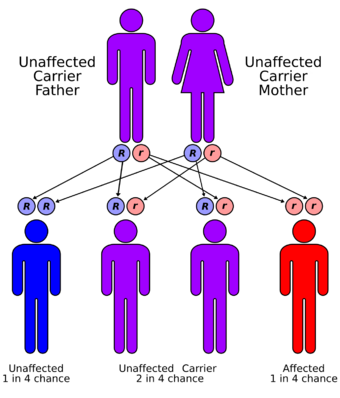Medicine:RIDDLE syndrome
From HandWiki
| RIDDLE syndrome | |
|---|---|
| Other names | Radiosensitivity-immunodeficiency-dysmorphic features-learning difficulties syndrome |
 | |
| Riddle syndrome is inherited in an autosomal recessive pattern. | |
RIDDLE syndrome is a rare genetic syndrome. The name is an acronym for Radiosensitivity, ImmunoDeficiency Dysmorphic features and Learning difficulties.
Presentation
The features of this condition include:[citation needed]
- Facial dysmorphism
- Short stature
- Mild motor control and learning difficulties
- Mild ataxia
- Microcephaly
- Normal intelligence
- Conjunctival telangiectasia
- Recurrent sinus infections
- Decreased serum IgA
- Late onset of pulmonary fibrosis
- Increased alpha-fetoprotein
- Increased radiosensitivity
Genetics
This condition is due to mutations in the RNF168 gene. It is inherited in an autosomal recessive fashion. The gene encodes a ubiquitin ligase and is located on the long arm of chromosome 3 (3q29) on the Crick (minus strand).[1]
Diagnosis
Differential diagnosis
The DDx is [citation needed]
- Ataxia telangectasia
- Artemis deficiency
- Immunodeficiency 26 (PKCS gene deficiency)
- LIG4 syndrome
- Nijmegen breakage syndrome
- Severe combined immunodeficiency with Cernunnos
- X-linked agammaglobulinemia
Management
Epidemiology
This condition is extremely rare. Only four cases have been described up to 2017.[2]
History
This syndrome was first described by Stewart et al. 2007.[3]
References
- ↑ "The RIDDLE syndrome protein mediates a ubiquitin-dependent signaling cascade at sites of DNA damage". Cell 136 (3): 420–34. February 2009. doi:10.1016/j.cell.2008.12.042. PMID 19203578.
- ↑ "Clinical and Biological Manifestation of RNF168 Deficiency in Two Polish Siblings". Frontiers in Immunology 8: 1683. 2017. doi:10.3389/fimmu.2017.01683. PMID 29255463.
- ↑ "RIDDLE immunodeficiency syndrome is linked to defects in 53BP1-mediated DNA damage signaling". Proceedings of the National Academy of Sciences of the United States of America 104 (43): 16910–5. October 2007. doi:10.1073/pnas.0708408104. PMID 17940005. Bibcode: 2007PNAS..10416910S.
| Classification | |
|---|---|
| External resources |
 |

